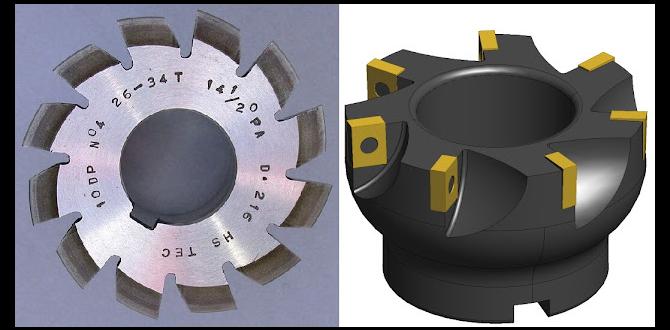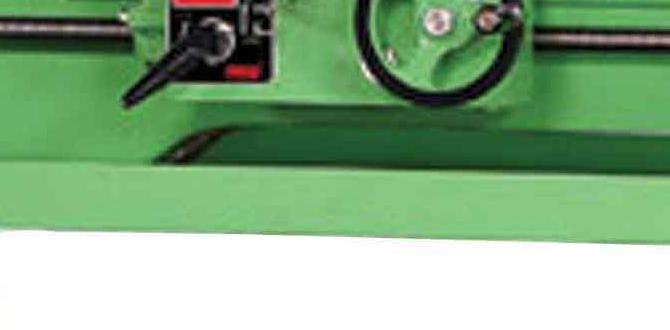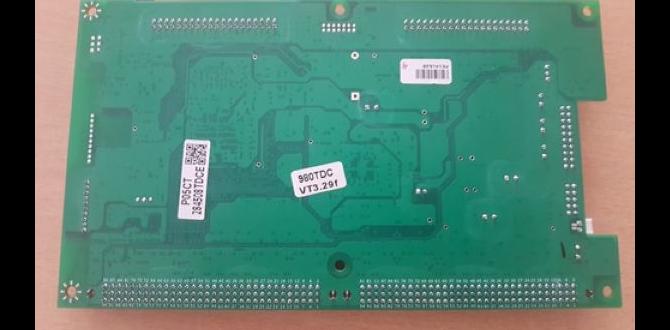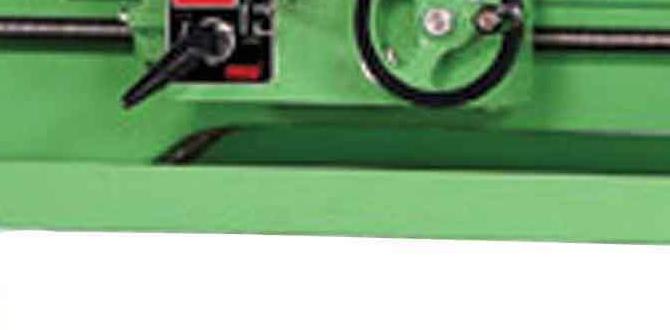A top-quality wood lathe sharpening jig is a game-changer for keeping your turning tools razor-sharp and effective. This review explores why a good jig is essential, helps you choose the right one, and shows you how to use it for precise, repeatable results.
Welcome to Lathe Hub! If you’re diving into the world of woodturning, you’ve probably noticed that dull tools can turn a fun project into a frustrating battle. Getting that perfect, clean cut relies on sharp chisels, and keeping them sharp consistently can be a real challenge. Many beginners struggle with freehand sharpening, leading to inconsistent edges and wasted effort. But don’t worry, there’s a fantastic solution that’s often overlooked: a wood lathe sharpening jig. It’s not just a handy accessory; it’s an essential tool for any serious woodturner seeking precision and ease. Let’s explore why this seemingly simple jig is a genius addition to your workshop.
Why a Wood Lathe Sharpening Jig is a “Genius Essential”
The primary goal of a wood lathe sharpening jig is to hold your turning tools at the correct angle against a sharpening surface, like a grinding wheel or a sharpening stone. This might sound straightforward, but achieving a consistent and precise bevel angle by hand is incredibly difficult. Even a slight wobble or inconsistency can ruin the edge you’re trying to create.
Think of it like this: hand-sharpening a tool is like trying to draw a perfectly straight line freehand. It’s possible, but it takes immense practice and skill. A jig, on the other hand, is like using a ruler. It guides your tool with absolute precision, ensuring that every pass refines the bevel to the exact angle you want. This consistency is crucial for several reasons:
- Repeatable Edges: Once you find the perfect angle and edge geometry for a particular tool or task, a jig allows you to reproduce it exactly, time after time. This saves you a lot of trial and error.
- Time Savings: While setting up a jig might take a moment, the actual sharpening process becomes much faster and more efficient. You’re not fighting to maintain an angle; you’re simply moving the tool through the jig.
- Tool Longevity: Consistent sharpening prevents you from removing more metal than necessary. This means your valuable turning tools will last longer.
- Improved Cutting Performance: A precisely sharpened edge cuts wood cleanly and efficiently. This leads to smoother finishes, less tear-out, and a more enjoyable turning experience.
- Reduced Frustration: Dull tools are the enemy of good woodworking. A sharpening jig makes the process less daunting, empowering you to keep your tools in peak condition with confidence.
For beginners, a sharpening jig removes a significant barrier to mastering woodturning. It allows you to focus on learning to shape wood, rather than wrestling with the complexities of tool maintenance. For seasoned turners, it’s about refining their craft and achieving the highest level of performance from their tools.
Understanding Different Types of Wood Lathe Sharpening Jigs
When you start looking into sharpening jigs, you’ll find there are a few main categories, each with its own strengths. The best choice for you will depend on the types of tools you use most and your preferred sharpening method (grinding wheel, stones, etc.).
Grinding Wheel Jigs
These are the most common types of jigs designed for use with bench grinders. They typically feature a platform or arm that allows you to rest your tool shank and then pivot or slide it against the grinding wheel.
- Pros: Excellent for quickly removing metal and reforming a damaged or excessively dull edge. They allow for precise angle control.
- Cons: Grinding generates heat, which can easily overheat and ‘draw the temper’ from your tool if done incorrectly. This requires a slower, more methodical approach and good cooling (like a water bath). They are generally for rougher sharpening and often followed by honing on finer abrasives.
Wheeled/Disc Grinding Jigs
Some jigs are designed to work with specialized disc or belt grinders, often found in sharpening systems. These can offer a very controlled and efficient way to sharpen. The abrasive surface is usually flatter and more consistent than a grinding wheel.
- Pros: Can provide a very fine and consistent abrasive surface. Often less prone to overheating than traditional grinding wheels.
- Cons: Systems can be more expensive. Limited to the specific abrasive types and grits available for the system.
Stone/Honing Jigs
These jigs are made for use with sharpening stones (whetstones, oil stones, diamond plates). They typically hold the tool at a specific angle allowing you to slide the stone along the bevel, or they hold the stone itself and you bring the tool to it. They are excellent for honing an edge and bringing it to a razor-sharp final finish.
- Pros: Ideal for achieving a super-fine, polished edge. Less risk of overheating your tools.
- Cons: Slower for significant reshaping of a bevel. Requires a good set of sharpening stones.
Universal vs. Specific Tool Jigs
Within these categories, you’ll find jigs that are universal (designed to hold a wide variety of tool shapes and sizes) and those that are specific to certain tools (like skew chisels, gouges, or scrapers).
- Universal Jigs: Offer flexibility but can sometimes be more complex to set up for a specific tool.
- Specific Jigs: Are often faster and easier to use for the tool they’re designed for, as they have dedicated holders or guides.
For a beginner, a good universal jig for a grinding wheel, paired with a basic system for honing, is often a great starting point. It covers the most common needs without overwhelming you with too many specialized options.
Popular Wood Lathe Sharpening Jig Models & Features
Many manufacturers offer excellent sharpening jigs. When evaluating them, consider the build quality, adjustability, and ease of use. Here are some features to look for:
Key Features to Consider:
- Adjustable Angle Settings: The ability to set and lock specific bevel angles is paramount. Look for clear markings or detents for common angles (25°, 30°, 40° are common).
- Tool Holding Mechanism: How does it securely grip your tools? Adjustable jaws, collars, or set screws are common. Ensure it holds your tool shank firmly without slipping.
- Smooth Movement: The jig should move smoothly against the abrasive surface without binding or excessive play. Ball bearings or robust slides are good indicators.
- Versatility for Tool Types: Can it accommodate the common tools you use – spindle gouges, bowl gouges, skew chisels, scrapers, parting tools, etc.?
- Durability and Material: Jigs are often made of cast iron, steel, or heavy-duty aluminum. A well-built jig will last for years.
While I can’t review every single jig on the market, here are some well-regarded types and what makes them stand out:
The “Standard” Grinding Jig (e.g., Delta/Shop Fox Style)
These are often found as standalone units or included with some grinders. They typically consist of a sliding arm that rests on the grinder housing or a separate stand, with an adjustable stop to set the bevel angle. You adjust the tool projection to set the angle.
Pros: Simple, effective, and relatively inexpensive. Can sharpen a good range of tools.
Cons: Can be a bit fiddly to set the exact angle consistently for every tool. Might require specific mounting to your grinder.
Jigs with Built-in Angle Selectors (e.g., Woodturners’ Tool Grinding Jigs)
Some systems offer a more integrated approach. You might have a jig that sits on your grinder’s tool rest, with a mechanism that allows you to set the angle definitively. Some even use adjustable stops for repeatable bevels. For a practical guide to tool rests and their importance, you can check out resources from woodworking associations like the American Association of Woodturners (AAW) which often discuss tool setup and maintenance, though they may not specifically review jigs. Their focus is on enhancing the practice of woodturning.
Pros: Highly repeatable angles, easier setup once understood. Often designed with specific tool geometries in mind.
Cons: Can be more expensive. Some are designed for specific grinders.
Specialized Systems (e.g., Tormek System)
The Tormek system is a prime example of a high-end sharpening station. It uses a slow-speed water-cooled grindstone and a wide array of specialized jigs that hold virtually any turning tool with incredible precision. While not strictly a “grinding wheel jig” in the traditional sense of a bench grinder attachment, it’s a complete sharpening solution that uses jigs. Its jigs are engineered for specific tool types (e.g., Tormek SVM-45 for short gouges, SVD-186 for long gouges).
Pros: Unmatched edge quality, virtually impossible to overheat tools, very consistent results. A comprehensive system for all your sharpening needs. Excellent for long-term tool care.
Cons: Significant investment. Requires dedicated space and slower workflow compared to a bench grinder sharpened edge.
For a beginner, I’d recommend starting with a quality universal grinding jig that works with your existing bench grinder. It offers the best balance of cost, capability, and learning potential. As you progress, you can always invest in more specialized jigs or systems.
How to Use a Wood Lathe Sharpening Jig: A Step-by-Step Guide
Let’s walk through the process of using a common bench grinder jig. The exact steps might vary slightly depending on your jig, but the principles are the same. Safety first! Always wear safety glasses and hearing protection when using a grinder.
Tools and Materials You’ll Need:
- Your wood lathe turning tools (gouges, scrapers, etc.)
- Your bench grinder
- Your chosen wood lathe sharpening jig
- A source of water for cooling (a bucket or specialized attachment)
- Cleaning rags
- Optional: Magnifying glass to check the edge
- Optional: A leather strop and honing compound for final polishing
Step 1: Prepare Your Grinder and Jig
Ensure your grinder wheels are clean, dressed (if necessary), and securely mounted. Attach your sharpening jig to the grinder’s tool rest or base according to its instructions. Make sure it’s firmly in place – stability is key.
Step 2: Set the Sharpening Angle
This is where the jig shines. If your jig has preset angle stops, select the angle appropriate for your tool. For example, a standard bowl gouge might be sharpened at 40-50 degrees, a skew chisel at 25-35 degrees, and a scraper at a shallower angle. If your jig requires you to set the angle by adjusting tool projection, insert a scrap piece of dowel or a spare tool and adjust until the desired angle is achieved against the wheel. I often use a protractor or an angle gauge to verify the setup the first time I use a new jig setting.
Tip: Different tools and wood types benefit from different bevel angles. For a great overview of sharpening geometry, Resources like Fine Woodworking often provide excellent diagrams and explanations well worth checking out.
Step 3: Position and Lock the Tool
Place your turning tool into the jig’s holder. Most jigs have jaws that tighten with a knob or screw, or a slot where the tool shank rests and is held by a cap or screw. Ensure the tool shank is held securely and won’t move. The cutting edge of the tool should be positioned so that it will contact the grinding wheel correctly when the jig is advanced.
Step 4: Sharpening – With Care and Coolant
- Slowly advance the jig (and the tool within it) towards the grinding wheel.
- Let the tool engage the wheel gently. Don’t force it.
- Grind for a few seconds, then pull the tool back.
- Crucially, dip the tool in water to cool it. Overheating can ruin the temper of the steel, making it soft and unable to hold an edge. Alternating brief grinding with cooling is vital.
- Periodically lift the tool from the jig to check the edge. You’re looking for a consistent burr forming along the entire cutting edge.
- Once a burr is formed and disappears after a few more passes, you’ve likely ground enough.
- Repeat on the other side if your tool geometry requires it (e.g., wing of a gouge).
Important Note on the Burr: The burr is a small, wire-like imperfection on the very edge that indicates you’ve ground through the metal. It’s not the final sharp edge itself but a sign that the grinding process has reached the very apex of the bevel.
Step 5: Hone the Edge
Grinding creates the bevel, but honing refines it into a truly sharp edge. Remove the tool from the jig (or switch to a honing jig/system if you have one). Use a fine sharpening stone, diamond plate, or leather strop with honing compound to polish away the burr and create a keen, smooth cutting edge. Stropping is often done freehand or with a specific stropping jig.
A good strop can make a dull-ground edge incredibly sharp. The goal here is to achieve a mirror polish on the bevel, which translates to a cleaner cut in wood.
Step 6: Test and Refine
Carefully test the sharpness of your tool on a scrap piece of wood. A sharp tool should glide through the wood with minimal effort. If it’s not sharp enough, go back to the grinder (briefly!) and then re-hone. Fine-tune your jig settings or technique as needed.
If you’re using a Tormek system or similar, follow its specific jig instructions, which are usually very intuitive and designed for minimal error. You can find excellent video guides on the Tormek website, demonstrating how to sharpen almost any woodturning tool with their jigs.
Sharpening Jigs vs. Other Sharpening Methods
It’s worth comparing jig-based sharpening to other common methods to understand why it’s often the preferred approach for woodturners.
Freehand Sharpening
This is sharpening without any jig, using just your hands to hold the tool against the grinding wheel or stone. It requires a very steady hand and a lot of practice to get consistent results.
| Method | Pros | Cons |
|---|---|---|
| Freehand Sharpening | No extra equipment cost. Can be very fast once mastered. | Extremely difficult to achieve consistent angles. High risk of overheating tools. Takes significant practice. Can lead to inconsistent and dull edges. |
| Sharpening Jig | Highly consistent and repeatable angles. Easier to learn and master. Reduces risk of overheating through controlled passes. Better edge geometry for improved cutting performance. | Initial cost for the jig. Requires a bit of setup time. Limited by grindstone/stone quality if not combined with good honing. |
For beginners, the learning curve for freehand sharpening is steep and often discouraging. A jig democratizes good sharpening technique, making it accessible to everyone.
Stones Only Sharpening
Some turners prefer to use only sharpening stones (water stones, oil stones, diamond plates). This method can produce incredibly sharp edges but doesn’t usually involve a jig; instead, it’s often done freehand or with a very simple stone-holding jig.
While stone sharpening is excellent for honing, it’s very slow for reshaping severely dulled tools or for correcting significant geometry issues. Bench grinders with jigs are much faster for initial reshaping and then followed by honing on stones.
Diamond Sharpening Systems
These can include diamond plates or diamond-coated sharpening rods. They are very effective and long-lasting. Many commercially available sharpening jigs can be adapted for use with diamond plates, giving you the best of both worlds: a guided sharpening process with a durable abrasive.
The advantage of jigs is their ability to hold the tool at the correct angle, regardless of the abrasive. This makes them versatile. For instance, many jigs designed for grinding wheels can also be used with diamond wheels or systems that mimic wheel shapes.
Ultimately, a jig is an investment in consistency and efficiency. It pairs well with most sharpening abrasives, helping you achieve superior results whether you’re using simple bench grinders or sophisticated water-cooled systems.
Maintaining Your Sharpening Jig
A good sharpening jig is built to last, but a little maintenance goes a long way:
- Cleanliness: After each use, wipe down your jig to remove abrasive dust and metal filings. A build-up can affect smooth movement.
- Lubrication: Check the manufacturer’s recommendations. Some sliding parts might






